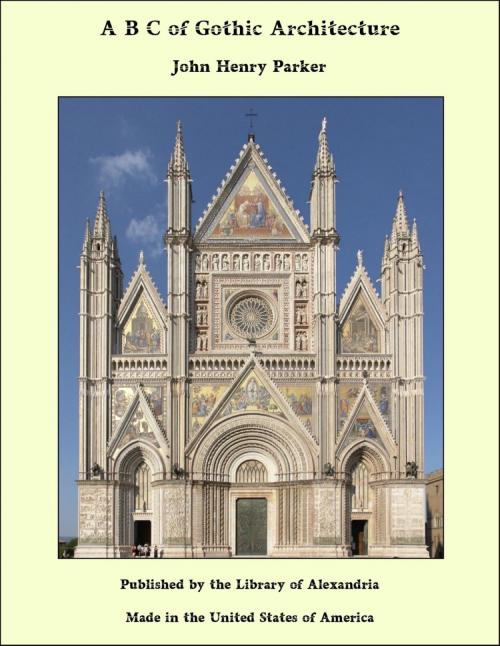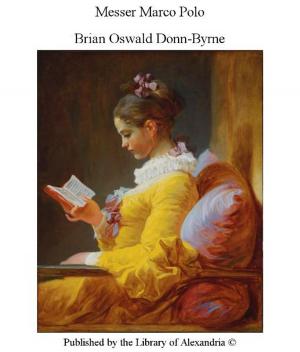A B C of Gothic Architecture
Nonfiction, Religion & Spirituality, New Age, History, Fiction & Literature| Author: | John Henry Parker | ISBN: | 9781465625557 |
| Publisher: | Library of Alexandria | Publication: | March 8, 2015 |
| Imprint: | Language: | English |
| Author: | John Henry Parker |
| ISBN: | 9781465625557 |
| Publisher: | Library of Alexandria |
| Publication: | March 8, 2015 |
| Imprint: | |
| Language: | English |
ARCHITECTURAL History can only be understood by the eye, either by seeing the buildings themselves, with time to examine the construction and the details of each period, or by accurate representations of them arranged in chronological order. This is what has been attempted in the present work; and when so arranged, any one, however ignorant of the subject, can see and understand the gradual progress and change from one generation to another. What is thus understood is also easily remembered; we can always remember what we have seen, much better than what we have only heard or read about; an accurate representation of each object is better than many pages of description, or of essays about it. The arrangement made in this little work will enable any one to understand the general principles of what are called the styles or periods of Gothic Architecture. Some persons object to this name, which was undoubtedly given originally in contempt by the admirers of the Palladian style, but it has been so generally adopted all over Europe for the last century or more, that it would be in vain to attempt to change it; it is a convenient name, which everybody understands as a general term for the different styles ofMEDIÆVAL ARCHITECTURE. Dr. E. A. Freeman has ingeniously suggested that it is the architecture of the Gothic nations who conquered the Roman Empire, and one of which to be proud rather than ashamed. Strictly speaking, the Norman is one of the Romanesque styles, which succeeded to the old Roman; but the Gothic was so completely developed from the Norman, that it is impossible to draw a line of distinction between them; it is also convenient to begin with the Norman, because the earliest complete buildings that we have in this country are of the Norman period, and the designs of the Norman architects, at the end of the eleventh century and the beginning of the twelfth, were on so grand a scale, that many of our finest cathedrals are built on the foundations of the church of that period, and a great part of the walls are frequently found to be really Norman in construction, although their appearance is so entirely altered that it is difficult at first to realize this; for instance, in the grand cathedral of Winchester, William of Wykeham did not rebuild it, but so entirely altered the appearance, that it is now properly considered as one of the earliest examples of the English Perpendicular style of which he was the inventor; this style is entirely confined to England, it is readily distinguished from any of the Continental styles by theperpendicular lines in the tracery of the windows, and in the panelling on the walls; in all the foreign styles these lines are flowing or flame-like, and for that reason they are called Flamboyant; a few windows with tracery of that style are met with in England, but they are quite exceptions.
ARCHITECTURAL History can only be understood by the eye, either by seeing the buildings themselves, with time to examine the construction and the details of each period, or by accurate representations of them arranged in chronological order. This is what has been attempted in the present work; and when so arranged, any one, however ignorant of the subject, can see and understand the gradual progress and change from one generation to another. What is thus understood is also easily remembered; we can always remember what we have seen, much better than what we have only heard or read about; an accurate representation of each object is better than many pages of description, or of essays about it. The arrangement made in this little work will enable any one to understand the general principles of what are called the styles or periods of Gothic Architecture. Some persons object to this name, which was undoubtedly given originally in contempt by the admirers of the Palladian style, but it has been so generally adopted all over Europe for the last century or more, that it would be in vain to attempt to change it; it is a convenient name, which everybody understands as a general term for the different styles ofMEDIÆVAL ARCHITECTURE. Dr. E. A. Freeman has ingeniously suggested that it is the architecture of the Gothic nations who conquered the Roman Empire, and one of which to be proud rather than ashamed. Strictly speaking, the Norman is one of the Romanesque styles, which succeeded to the old Roman; but the Gothic was so completely developed from the Norman, that it is impossible to draw a line of distinction between them; it is also convenient to begin with the Norman, because the earliest complete buildings that we have in this country are of the Norman period, and the designs of the Norman architects, at the end of the eleventh century and the beginning of the twelfth, were on so grand a scale, that many of our finest cathedrals are built on the foundations of the church of that period, and a great part of the walls are frequently found to be really Norman in construction, although their appearance is so entirely altered that it is difficult at first to realize this; for instance, in the grand cathedral of Winchester, William of Wykeham did not rebuild it, but so entirely altered the appearance, that it is now properly considered as one of the earliest examples of the English Perpendicular style of which he was the inventor; this style is entirely confined to England, it is readily distinguished from any of the Continental styles by theperpendicular lines in the tracery of the windows, and in the panelling on the walls; in all the foreign styles these lines are flowing or flame-like, and for that reason they are called Flamboyant; a few windows with tracery of that style are met with in England, but they are quite exceptions.















